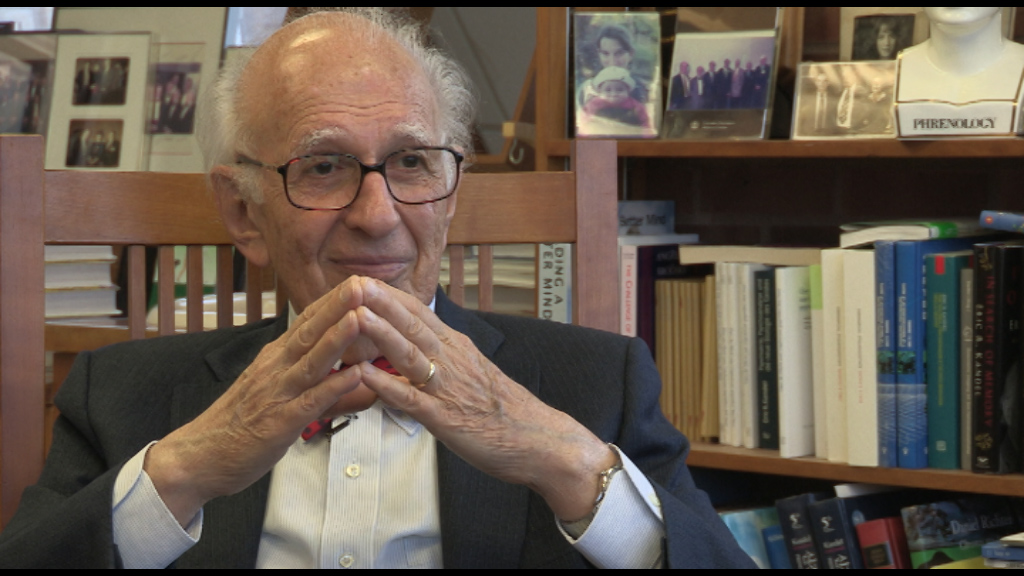NEXT STORY

Moving to New York
RELATED STORIES

NEXT STORY

Moving to New York
RELATED STORIES


|
Views | Duration | |
|---|---|---|---|
| 31. An exceptionally rewarding year | 75 | 01:14 | |
| 32. Driven to study Aplysia by a sense of adventure | 78 | 01:40 | |
| 33. Being in the right place at the right time | 86 | 01:24 | |
| 34. Setting up my own lab | 76 | 01:28 | |
| 35. Mapping the ganglion | 69 | 00:41 | |
| 36. Recording connections between cells | 65 | 02:27 | |
| 37. Moving to New York | 63 | 02:12 | |
| 38. Division for Neurobiology and Behavior | 95 | 05:08 | |
| 39. Exploring the mechanism behind habituation and dishabituation... | 132 | 04:41 | |
| 40. A good syllabus is like a symphony | 63 | 03:17 |


I then asked Coggeshall to join in because we were beginning to map connections between cells and he was a very good anatomist. So it then dawned on us that maybe we could map connections between cells. And we found something very interesting. We started to record from cells, two at a time, instead of one at a time, to look at connections between them. And we found something very odd. We found if we recorded from certain cells, that there were inhibitory synaptic potentials in one cell that were synchronous with excitatory synaptic potentials in the other cell. Wow, that's odd. That suggested that a single cell was producing different synaptic actions on different follower cells. That had never been described before. There had been what Eccles has called Dale's principle. A neuron released only one transmitter which produces only one synaptic action at all of its terminals. This seemed to be a violation of Dale's principle. So we hunted around and we hunted around and boom we found a cell, L10, that produced excitation on some cells and inhibition on the others. We could clearly show, this was mediated by the same transmitter: acetylcholine excited one cell, inhibited the other. Acetylcholine receptor blockers blocked it.
Moreover, not only was this a fascinating finding, and Coggeshall helped us actually trace the connections, but it showed for the first time you could map connections between single cells in a neural structure. This had never been done before, but this really opened up the studying of neural circuitry, and that was really very encouraging. And then with Howard Wachtel and with Daniel Gardner, we went on to show a further variation of it, that some cells receive from the same synaptic neuron, L10, both excitation and inhibition. If you stimulate it slowly, you had excitatory synaptic potentials, if you now speeded it up, it converted to inhibition - really quite remarkable - mediated by acetylcholine. So just by combining receptors in different ways with different kinetics, you can get all kinds of synaptic properties.
So that convinced me we could begin to work out the neural circuitry of the behavior.
Eric Kandel (b. 1929) is an American neuropsychiatrist. He was a recipient of the 2000 Nobel Prize in Physiology or Medicine for his research on the physiological basis of memory storage in neurons. He shared the prize with Arvid Carlsson and Paul Greengard. Kandel, who had studied psychoanalysis, wanted to understand how memory works. His mentor, Harry Grundfest, said, 'If you want to understand the brain you're going to have to take a reductionist approach, one cell at a time.' Kandel then studied the neural system of the sea slug Aplysia californica, which has large nerve cells amenable to experimental manipulation and is a member of the simplest group of animals known to be capable of learning. Kandel is a professor of biochemistry and biophysics at the College of Physicians and Surgeons at Columbia University. He is also Senior Investigator in the Howard Hughes Medical Institute. He was the founding director of the Center for Neurobiology and Behavior, which is now the Department of Neuroscience at Columbia University. Kandel's popularized account chronicling his life and research, 'In Search of Memory: The Emergence of a New Science of Mind', was awarded the 2006 Los Angeles Times Book Award for Science and Technology.
Title: Recording connections between cells
Listeners: Christopher Sykes
Christopher Sykes is an independent documentary producer who has made a number of films about science and scientists for BBC TV, Channel Four, and PBS.
Tags: Dale’s principle, Richard Coggeshall
Duration: 2 minutes, 27 seconds
Date story recorded: June 2015
Date story went live: 04 May 2016